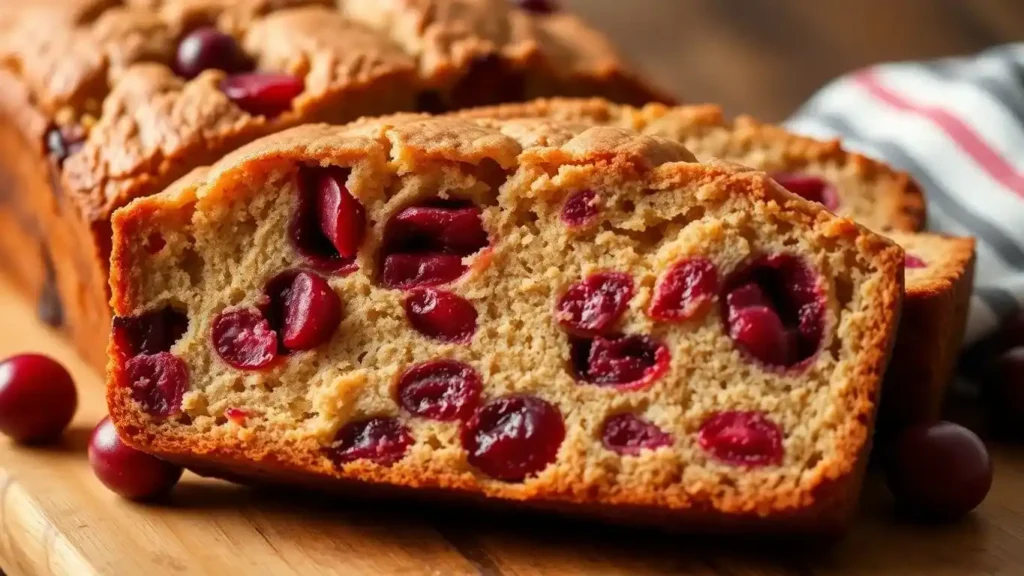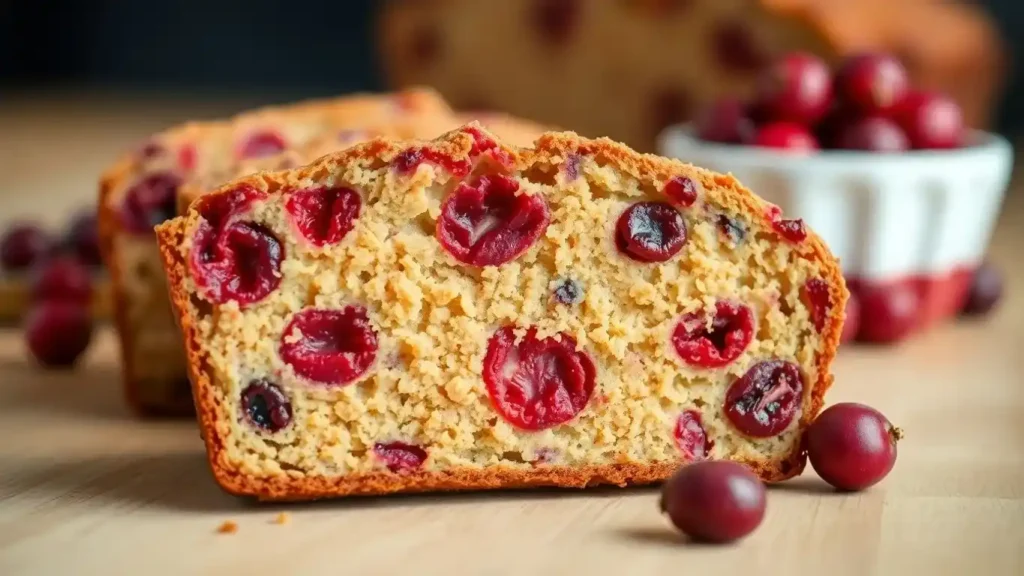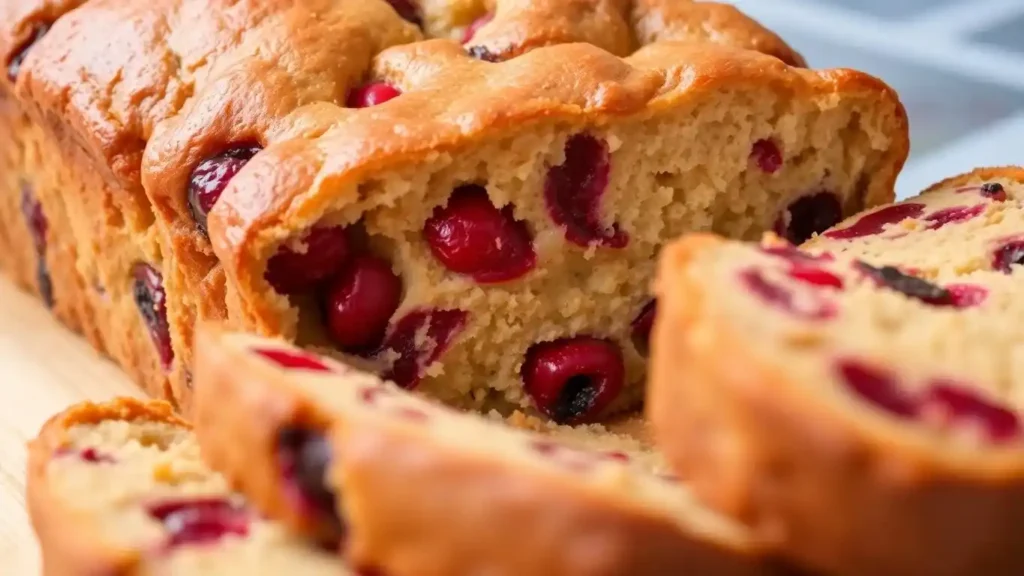Ever had your cranberry bread fall apart just when you were about to enjoy a slice? It’s a common issue, but don’t worry there’s a fix. Whether it’s the ingredients, mixing method, or even how you bake it, small tweaks can make a big difference. Let’s dive into why your cranberry bread might be crumbling and how to keep it intact.
Table of contents
Key Takeaways
- Don’t overmix your batter; it can make the bread gummy and more likely to fall apart.
- Use light brown sugar to add moisture and flavor, helping to bind the bread.
- Make sure the bread cools completely before slicing to prevent crumbling.
- Use a sharp serrated knife for slicing to keep the bread intact.
- Consider adding nuts or chocolate chips for texture and flavor, but adjust the cranberry amount accordingly.
Understanding the Ingredients in Cranberry Bread

The Role of Fat and Eggs
Fat and eggs are like the backbone of your Cranberry Bread. They help hold everything together, giving the bread its structure and moist texture. The fat, often from butter or oil, adds richness and flavor. Butter is great for its taste, but you can swap it for a neutral oil if you’re avoiding dairy. Eggs, on the other hand, bind the ingredients. Without enough fat or eggs, your bread might crumble apart or feel dry.
Importance of Fresh Cranberries
Fresh cranberries are key to making your bread pop with flavor. They provide a tangy flavor that offsets the sweetness from the sugar. Plus, fresh cranberries have more moisture than dried ones, which helps keep the bread from drying out. If you can’t find fresh cranberries, frozen ones are a good substitute, but remember they might make the baking time a bit shorter.
Using Brown Sugar for Moisture
Brown sugar isn’t just for sweetness; it also keeps your bread moist. The Molasses in brown sugar contributes a rich, robust flavor and helps retain moisture in the bread. This is especially useful if you find your bread tends to dry out or fall apart. Switching to brown sugar can make a noticeable difference in the texture and taste of your Cranberry Bread.
Mastering the Mixing Technique
Avoiding Overmixing the Batter
Mixing your cranberry bread batter just right is key to keeping it from falling apart. Overmixing can lead to a dense and crumbly loaf. When you mix, aim for a smooth consistency but stop as soon as the dry ingredients are moistened. This ensures the gluten in the flour doesn’t develop too much, which can make the bread tough.
Incorporating Dry Ingredients Properly
Adding your dry ingredients gradually can make a big difference. Sift your flour and other dry ingredients to aerate them, and then fold them into the wet mixture in small batches. This helps to keep the batter light and airy. Remember, a gentle hand is your best tool here.
Folding in Cranberries Gently
When it comes to adding cranberries, be gentle. You want to fold them in carefully to avoid breaking them, which can lead to uneven moisture distribution and a soggy bottom. This step takes a little patience, but it’s worth it for a perfect texture.
Taking ample time with each step in mixing can truly make or break your cranberry bread. Rushing through can lead to a disappointing bake, so give yourself those extra minutes to ensure everything is just right.
By focusing on these mixing techniques, you’ll be well on your way to a cranberry bread that holds together beautifully, ready to bake for 65-70 minutes until perfectly done. If you’re interested in avoiding common baking issues like dryness and flavor imbalances, consider exploring kefir sheet cake variations for more tips and tricks.
Perfecting the Baking Process
Preheating the Oven Correctly
Ensuring your oven is preheated to the right temperature is crucial for a successful cranberry bread. Aim for a consistent temperature, usually around 350 degrees Fahrenheit, but always check with an oven thermometer to be sure. This simple tool can help you avoid uneven baking caused by inaccurate oven temperatures. Also, resist the urge to open the oven door frequently as this can cause temperature fluctuations.
Positioning the Bread Pan
Positioning your bread pan correctly in the oven can make a big difference. Place the pan in the center of the oven to ensure even heat distribution. If you’re using a metal loaf pan, it will conduct heat more efficiently than glass or ceramic, which might need extra baking time. Avoid dark-colored pans, as they can cause the bread to brown too quickly.
Testing for Doneness
To test if your cranberry bread is done, use a toothpick or an oven thermometer. Insert the toothpick into the center of the bread; if it comes out clean, the bread is ready. Alternatively, check the internal temperature with an oven thermometer; it should read between 200-205 degrees Fahrenheit for quick breads like cranberry bread. If it’s not quite there, give it a bit of time longer in the oven, but keep an eye on it to prevent overbaking.
Baking cranberry bread is an art that requires patience and precision. By focusing on the details, like accurate ingredient measurements and proper baking techniques, you can create a delicious, moist loaf every time.
Cooling and Slicing Your Cranberry Bread
Allowing Bread to Cool Completely
After pulling your cranberry loaf of bread from the oven, patience is key. Let it cool in the pan for about 10-20 minutes. This gives the bread a chance to settle and makes it easier to handle without falling apart. Once it’s had a minute cool in the pan, gently transfer it to a wire rack. Here, it should cool for an additional 30-40 minutes. This step ensures the bread firms up properly, making slicing a breeze.
Using the Right Knife for Slicing
When it comes time to slice, grabbing the right knife is crucial. A serrated knife is your best friend here. It cuts through the crust without crushing the soft inside. Start at one end of the loaf and saw gently without pressing down too hard. This technique helps keep each slice intact.
Preventing Crumbling While Cutting
To avoid a crumbly mess, make sure your cranberry bread is completely cool before slicing. If you rush this step, you risk turning your bread into a pile of crumbs. Also, using a sharp knife and steady hand can make all the difference. If you find your bread still crumbles, consider adjusting your recipe next time by adding a bit more fat or eggs to the bowl. This can provide extra moisture and binding.
Letting your cranberry bread cool fully and using the right slicing technique can make a world of difference in presentation and texture. Don’t rush these final steps; the payoff is a beautifully sliced loaf ready to enjoy with a bit of butter or a splash of fresh juice.
For more on creating a perfect cranberry bread, including tips on mixing techniques and ingredient choices, check out this cranberry bread recipe that combines tart cranberries with a zesty orange twist.
Troubleshooting Common Issues

Identifying Overbaking Signs
Overbaking can turn your cranberry bread into a dry, crumbly mess. One of the first signs is a dark, thick crust that looks more toasted than golden brown. If you notice this, reduce your baking time by five-minute increments. Another clue is if the bread pulls away from the sides of the pan too quickly. Use a toothpick to check for doneness—if it comes out clean, your bread is ready.
Adjusting for Altitude Changes
Baking at high altitudes can be tricky because the air pressure is lower, affecting how your bread rises. Here are some adjustments:
- Decrease baking powder by 1/8 teaspoon for every teaspoon.
- Increase liquid ingredients by 1-2 tablespoons.
- Raise the oven temperature by 15-25 degrees Fahrenheit.
These small changes can make a big difference in the texture and structure of your bread.
Dealing with Sticky Bottoms
A sticky bottom is usually the result of underbaking or a pan that’s not properly greased. Make sure to grease your pan well before pouring in the batter. If you still encounter stickiness, try lining the bottom with parchment paper. Also, ensure your oven is preheated and use an oven thermometer to verify the temperature.
Sometimes, even when you follow the recipe to the letter, things go awry. Don’t be discouraged; baking is as much about learning from mistakes as it is about enjoying the successes.
Enhancing Your Cranberry Bread Recipe

Adding Nuts or Chocolate Chips
Adding a twist to your cranberry bread with nuts or chocolate chips can be a game changer. Incorporating these ingredients not only adds texture but also enhances the flavor profile of your bread. Consider using chopped walnuts or pecans for a nutty crunch, or semi-sweet chocolate chips for a sweet surprise. You can try a 50/50 mix of dried cranberries and chocolate chips for a delightful contrast.
Experimenting with Different Flavors
Why stick to just one flavor when you can mix it up? Cranberry bread pairs well with a variety of flavors. Try adding a hint of vanilla extract or a teaspoon of cinnamon for a warm, spicy note. If you love citrus, a splash of orange juice or zest can turn your bread into a refreshing cranberry orange bread. You can also explore using different sugars, like substituting brown sugar with white sugar, to see how it changes the taste.
Creating a Glaze for Extra Moisture
A simple glaze can do wonders for quick breads, adding both moisture and a glossy finish. Mix powdered sugar with a bit of milk or orange juice for a sweet, tangy topping. Drizzle this over your cooled cranberry bread for a touch of elegance and added flavor. This technique works well with other quick bread recipes, like banana breads or pumpkin bread, too.
A little creativity with your cranberry bread can make all the difference. Don’t be afraid to try new ingredients or techniques—sometimes, the best recipes come from a bit of experimentation. Whether you’re a fan of fresh cranberries or prefer the convenience of frozen cranberries, there’s always room to play around with your favorite quick bread recipes.
Wrapping It Up
So, there you have it. Cranberry bread falling apart is more common than you’d think, but it’s not the end of the world. Just remember, don’t overmix your batter, and let it cool completely before slicing. Using a sharp knife helps too. If you’re feeling adventurous, try mixing in some nuts or other dried fruits. And hey, if it still crumbles a bit, just call it rustic and enjoy it anyway. Baking is about having fun and learning, so keep experimenting until you get it just right. Happy baking!
Frequently Asked Questions
Why does my cranberry bread crumble when I slice it?
Your cranberry bread might crumble if there isn’t enough fat or eggs in the batter, or if it’s overbaked. Also, using a serrated knife and letting the bread cool completely before slicing can help prevent crumbling.
Can I use fresh or frozen cranberries in my bread?
Yes, you can use either fresh or frozen cranberries. Fresh cranberries might bake a bit faster, so check your bread a little earlier if using them.
How can I stop my cranberry bread from being gummy?
To avoid gummy bread, make sure not to overmix the batter. Use a spoon or spatula instead of an electric mixer to gently combine the ingredients.
What can I do if I run out of cranberries?
If you run out of cranberries, you can use other dried fruits like raisins, blueberries, or cherries. You can also mix them to create a fruity blend.
How should I store my cranberry bread?
Wrap your cranberry bread tightly in foil or plastic wrap and place it in an airtight container. It can be stored at room temperature for a few days or in the freezer for up to three months.
How do I know when my cranberry bread is done baking?
You can check if your bread is done by inserting a toothpick into the center. If it comes out clean or with just a few crumbs, the bread is ready. If using fresh cranberries, check a bit earlier.
